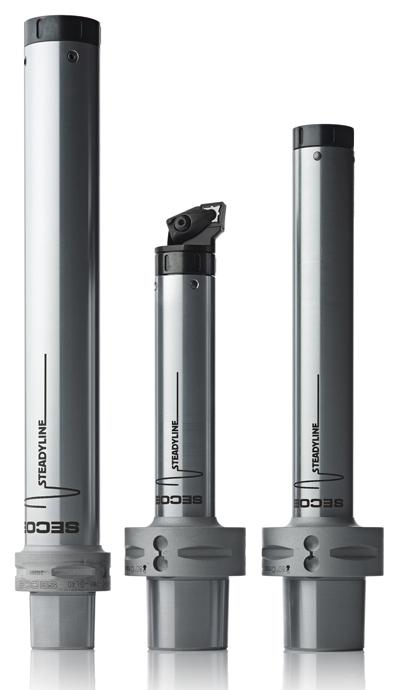
Following the success of its Steadyline milling holders, Seco Tools LLC has added turning bars to this line of damped anti-vibration tooling that brings excellent productivity results to a wide variety of long overhang machining operations. The new patented GL connection on these turning tools makes it possible to perform static and rotating operations with the same bar.
These highly rigid and stable turning bars effectively reduce unwanted vibrations in extreme cutting conditions. This is accomplished via a "dynamic passive system" inside the holder body where a heavy metal mass counter acts vibrations created by the holder's flex during machining operations. Steadyline products can perform typical long overhang operations with higher productivity then traditional tools, reducing spindle stress as well as offering high metal-removal rates, smooth part surface finishes and long tool life.
The extremely precise GL connection on these turning bars has a polylobe taper-interface with two 180-degree positions that orient the tool's cutting edges either face up or face down for effective chip control. The connection also has a strong, fast locking capability that is made possible via a single integrated clamping ring that draws in the tool head for a secure, stable taper-face contact. Once a turning bar is set it becomes possible to mount and remount tooling heads without having to reset the system.
While common traditional systems use several fastening screws and devices for exchanging tooling heads, the GL connection on the Steadyline turning bars requires only the use of a spanner wrench to loosen and tighten the tool heads.
Available in 6xD, 8xD and 10xD, a range of types, including Seco-Capto C4, C5 and C6, and a broad selection of turning heads for CN, DN, WN, CC, DC, TC, TN and RN inserts as well as heads for Snap-Tap threading, these turning bars can handle a variety of applications and operations, including roughing, finishing, threading and grooving. In addition, these bars feature coolant supply channels for enhanced chip evacuation.
Contact Details
Related Glossary Terms
- coolant
coolant
Fluid that reduces temperature buildup at the tool/workpiece interface during machining. Normally takes the form of a liquid such as soluble or chemical mixtures (semisynthetic, synthetic) but can be pressurized air or other gas. Because of water’s ability to absorb great quantities of heat, it is widely used as a coolant and vehicle for various cutting compounds, with the water-to-compound ratio varying with the machining task. See cutting fluid; semisynthetic cutting fluid; soluble-oil cutting fluid; synthetic cutting fluid.
- gang cutting ( milling)
gang cutting ( milling)
Machining with several cutters mounted on a single arbor, generally for simultaneous cutting.
- grooving
grooving
Machining grooves and shallow channels. Example: grooving ball-bearing raceways. Typically performed by tools that are capable of light cuts at high feed rates. Imparts high-quality finish.
- milling
milling
Machining operation in which metal or other material is removed by applying power to a rotating cutter. In vertical milling, the cutting tool is mounted vertically on the spindle. In horizontal milling, the cutting tool is mounted horizontally, either directly on the spindle or on an arbor. Horizontal milling is further broken down into conventional milling, where the cutter rotates opposite the direction of feed, or “up” into the workpiece; and climb milling, where the cutter rotates in the direction of feed, or “down” into the workpiece. Milling operations include plane or surface milling, endmilling, facemilling, angle milling, form milling and profiling.
- threading
threading
Process of both external (e.g., thread milling) and internal (e.g., tapping, thread milling) cutting, turning and rolling of threads into particular material. Standardized specifications are available to determine the desired results of the threading process. Numerous thread-series designations are written for specific applications. Threading often is performed on a lathe. Specifications such as thread height are critical in determining the strength of the threads. The material used is taken into consideration in determining the expected results of any particular application for that threaded piece. In external threading, a calculated depth is required as well as a particular angle to the cut. To perform internal threading, the exact diameter to bore the hole is critical before threading. The threads are distinguished from one another by the amount of tolerance and/or allowance that is specified. See turning.
- turning
turning
Workpiece is held in a chuck, mounted on a face plate or secured between centers and rotated while a cutting tool, normally a single-point tool, is fed into it along its periphery or across its end or face. Takes the form of straight turning (cutting along the periphery of the workpiece); taper turning (creating a taper); step turning (turning different-size diameters on the same work); chamfering (beveling an edge or shoulder); facing (cutting on an end); turning threads (usually external but can be internal); roughing (high-volume metal removal); and finishing (final light cuts). Performed on lathes, turning centers, chucking machines, automatic screw machines and similar machines.

